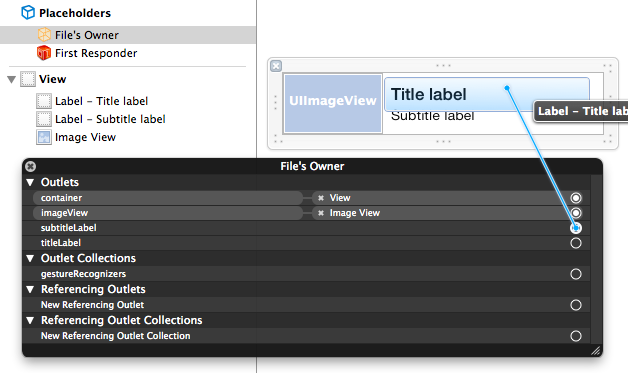Benedict's Soapbox
Loading a UIView subclass from a NIB
Nibs are great. They reduce the drudgery of view layout and allow us to work at a level of abstraction that matches the problem domain. But things aren’t all rosy. There are aspects of the implementation that leave room for improvement. The most common usage of nibs (in iOS at least) is to setup the view for a UIViewController. Some times, however, we want to re-use a specific subview between these nibs but it’s not obvious how best to do this. Here’s how to load a view from a nib so that the view can be instantiated in code and from other nibs.
-
Create a UIView sub class and a nib file:

- Add properties with IBOutlet annotations for the subviews in a class extension in the .m file:
@interface BCDemoView () @property(nonatomic) IBOutlet UIImageView *imageView; @property(nonatomic) IBOutlet UILabel *titleLabel; @property(nonatomic) IBOutlet UILabel *subtitleLabel; @end - Add an another property for a UIView container:
@interface BCDemoView () @property(nonatomic) IBOutlet UIImageView *imageView; @property(nonatomic) IBOutlet UILabel *titleLabel; @property(nonatomic) IBOutlet UILabel *subtitleLabel; @property(nonatomic) IBOutlet UIView *container; @end - Redeclare the subviews you wish to expose publicly in the header file:
@interface BCDemoView : UIView @property(nonatomic, readonly) UIImageView *imageView; @property(nonatomic, readonly) UILabel *titleLabel; @property(nonatomic, readonly) UILabel *subtitleLabel; @end - Configure the nib so that:
-
the file owner is an instance of your class:

-
the base UIView is connected to the container property of the file owner:

-
the remaining outlets are connected to subviews of the container view:

-
- Implement initWithFrame: (used when creating the view in code) and initWithCoder: (used when creating from a nib) to load the view from the nib:
@implementation BCDemoView
-(id)initWithFrame:(CGRect)frame
{
self = [super initWithFrame:frame];
if (self == nil) return nil;
[self initalizeSubviews];
return self;
}
-(id)initWithCoder:(NSCoder *)aDecoder
{
self = [super initWithCoder:aDecoder];
if (self == nil) return nil;
[self initalizeSubviews];
return self;
}
-(void)initalizeSubviews
{
//Load the contents of the nib
NSString *nibName = NSStringFromClass([self class]);
UINib *nib = [UINib nibWithNibName:nibName bundle:nil];
[nib instantiateWithOwner:self options:nil];
//Add the view loaded from the nib into self.
[self addSubview:self.container];
}
@end
A few things to note
- The nib file is an implementation detail of the class. We could replace the nib with the equivalent code and the interface would not change so no other classes will be affected. (All other examples I’ve seen require the code that instantiates the view to know about the implementation details of the nib.)
- The property are defined as readonly in the .h file and redefined as readwrite in the .m file. This restricts the scope of the mutability to a minimum (mutability is one of the places bug really like to live). (Also note that there are no IBOutlets in the header file as these are implementation details).
- The IBOutlet properties are strong (the default), not weak. Using weak for anything except a back-edge in the object graph, e.g. a delegate property, is incorrect. Using weak for views is an abuse of the knowledge we have about the implementation of UIKit.
- The method called by both initWithFrame: and initWithCoder: is called initalizeSubview. This is one of the conventions I have developed over the years: Any method that should only be called by an init method should start with initalize… . This is to differentiate it from the actual init methods. Such methods should appear rarely because most of the time all the initalization is done be the designated initializer (initWithCoder: is a special case). (See Epigrams on Programming number 10).
- Because we’re using a separate nib we can opt in and out of auto-layout independently from the other views.